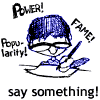![[ NEWS ]](/images/news97.gif)
Arizona Daily Wildcat May 7, 1997
Tucson High telescope project nears the end
Volunteers from the Steward Observatory Mirror Lab are working with high school students to cast another record breaking mirror - this time casting a mirror for the largest telescope within Tucson city limits."It's all being done by volunteers," said Patrick Woida, project manager and research specialist at Steward Observatory.
Friday, the lab will begin casting a 0.8-meter primary mirror for the observatory at Tucson High Magnet School, 400 N. Second Ave., Woida said.
Melissa Pesce-Rollins, a senior at Tucson High, worked on the prototype optics for her high school's telescope.
"I've gained a lot of experience," Pesce-Rollins said. "I've been inspired to go into this field."
Pesce-Rollins said she and Rigel Woida, Patrick Woida's son, worked as partners on the optics at the UA optical science center.
She said she felt she was gaining a lot of knowledge she could not get from textbooks.
"I'm actually doing it," Pesce-Rollins said.
To cast the mirror, the University of Arizona is donating 140 pounds of leftover borosilicate glass from the 8.4-meter Large Binocular Telescope mirror being recast in the lab's rotating furnace.
The UA is donating about $20,000 for the project and Tucson High is contributing about $30,000.
Scientists made a miniature scale model to work out optical design problems in advance, a process that saved about $30,000, Woida said.
The mirror's design will be a lightweight, ribbed structure that incorporates a radial design instead of the hexagonal "honeycomb" design used by the LBT mirror, Woida said.
He said the furnace will not need to rotate since the mirror is relatively small, but the temperature will be monitored and controlled. The glass will be heated in a cube-shaped furnace for about three to six weeks, Woida said.
The mirror will not be ready for installation until late fall. Once installed, the telescope will be linked for "real-time" remote control, enabling students from Tucson High and other high schools to send commands to the telescope via modem.
With the new telescope, Woida said students would not have to mail in their research proposals and wait for the observation data to come back. He said they could access control of the telescope and get immediate feedback.
"You're in control," Woida said.




